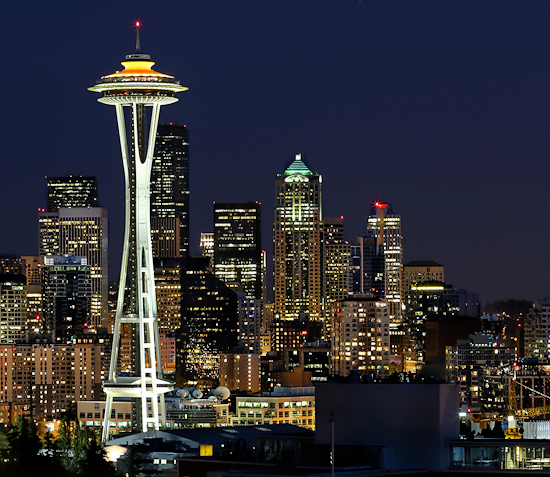
Canon 5D Mark III, f/13 @ 100mm, 30 sec, ISO 100, Tripod, Mirror Lockup, 30 sec timer
Image shown is cropped and edited, but click to view unedited in-camera JPEG
Cityscape shots are a little tricky because it’s tough to get a good overall image focus. In the shot above, I used my Canon 5D Mark III to dial in focus to get the best focus possible before taking the shot. After focusing, the only variable I couldn’t control was the wind, but for a 30 second exposure the result was okay – not great, but okay. (NOTE: The shot you see above is cropped and edited – click the image to see the out of camera original)
Once I have my settings dialed in, I switch to manual focus and use Live View at its maximum zoom to adjust my focus on items in the foreground and background to get the best balance of focus across the entire image. This is the greatest reason to use Live View in my opinion, so it’s automatic anytime I’m doing any shot that will allow me to use it (typically landscape or other static subject work).
For this to work my camera must be on a tripod and my subject must be static. The scene above of Seattle is a great test, so I took a few shots. While I’m not super happy with any of the shots I took due to wind, one of the huge problems I had during this test when comparing the Canon 5D Mark III against the Nikon D800 was the performance of the Live View on the D800.
Simply put, I found the Live View feature on the D800 to be unusable at maximum zoom under low light conditions like these. When I would zoom in with the Canon I’d get great detail and could easily dial in my focus on a detail like the people in top of the Space Needle. However, when I zoomed in with the Nikon all I could see was noise like you’d see on a old analog color TV. It was horrible and unusable!
Evidence of the D800 Live View Zoom Bug
Now, I know my comment in the last paragraph will infuriate D800 owners and Nikon fanboys, so I created a little video to show what I mean. Let’s start by saying that both cameras were on their default Live View settings and focusing on this piece of tile:

It was low light at night, but there’s some ambient light from three overhead lights. I set both cameras to use a tungsten white balance and zoomed in digitally to the maximum value each camera would allow (which is what I always do when using Live View for focusing).
In the video below the D800 is on the left and the 5D Mark III is on the right:
I find the results of the D800 to be so horrible that I really am starting to wonder if it is a bug worthy of a recall. I can use a Rebel T2i and get better results than the D800, so with Nikon’s claims of video parity and in some cases superiority to Canon’s video support, how can they expect people to use this?
The consequence of this bug meant that despite my best attempts, the best shots I was able to take that evening were these two shots both of which aren’t focused very well. Sadly autofocus didn’t even create an image worth saving:
So much potential lost due to the inability to focus accurately with Live View
Unedited in-camera JPEG D800 f/11 @ 200mm, 30s, ISO 100
Click for original
D800, f/14 @ 112mm, 4s, ISO 100, Unprocessed, AWB
Click for unedited JPEG original
The D800 would clearly be the better camera for this shot with the right lens (and I don’t think the Nikkor 70-200mm f/2.8G ED VR II is the right lens for this one). However, you need to have precision focusing for a shot like this and that was impossible with the D800.
My best shots were done when I focused through the viewfinder with the diopter adjusted to the best view I could get out of the D800. Focusing to infinity and taking a shot in the dark didn’t result in a better shot either as one might expect.
Update
Here’s a few shots I took with my iPhone of the problem while I was at the Space Needle:

As you can see, it’s hard to do precision focusing with this.
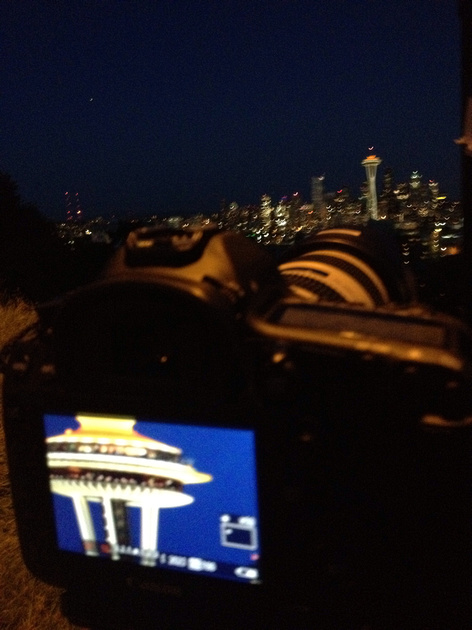
The 5D Mark III was much easier to use for seeing detail on the Space Needle and getting a sharp accurate focus.
I should also note that some have tried to raise concerns about my pics due to the wind. To that I say, ignore the output photos and focus on the facts clearly illustrated by these photos here. The LCD has massive noise on the D800 and the 5D Mark III does not. Of the two LCD screens above, which did you think is easier to use to achieve an accurate focus?
Conclusion
If I were a D800 owner, I’d be very mad about this and would use this video (or your own) as evidence to Nikon that they could do better. Hopefully they will in a future update as the D800 has so much potential for landscapes and cityscapes that it would be a shame if they could only be done during good light for the best focusing experience.
Despite what people might think, I actually like Nikon cameras. I like Canon and Fujifilm too! I wrote this article to raise awareness of what I believe to be a bug that limits the usability of the D800, not to bash it. My hope is that Nikon can and will fix this issue to create a Live View feature that is on par with Canon. This is what Nikon owners who have bought this camera deserve, so I hope this article helps make that possible.
There’s a lot to like about the D800, so learn more about how it stacks up in my article entitled COMPARISION: Nikon D800 vs Canon 5D Mark III.
Disclaimer
If you make a purchase using links found in this article, I may make a commission.

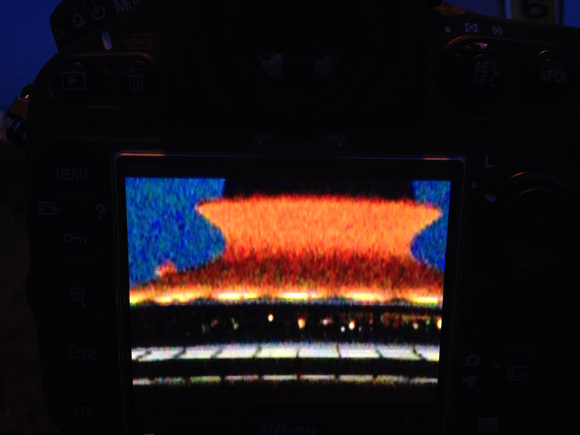
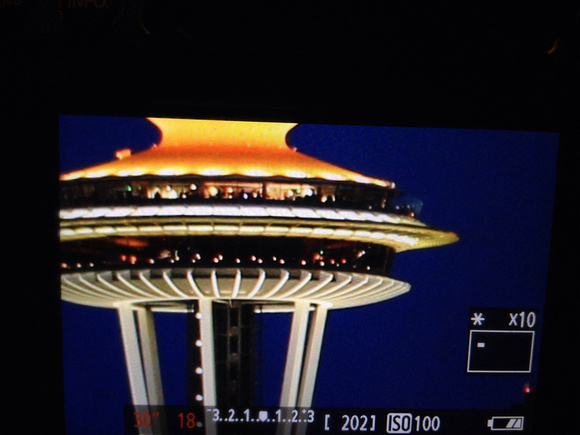
38 comments:
Wow, that's horrible. Nicely done post and nicely balanced write up.
Thanks Chris!
Hi Ron, good post.
Have a look at this post that talks about a confirmed viewfinder and focus problem. It mentions live view in passing but not what the results were. It would be interesting to find out if the camera you're using is in the "bad batch".
On a different topic, when I shot a sunrise on Maui the wind coming in was shaking my camera and the shots were unusable. The next morning I went back to the same spot but instead of my tripod I took a few towels from the hotel, placed them on a handy rock to cushion my camera, and re-shot the scene.
Ed
Thank you Ron for this and the other considered comments. I had pondered the D800 for architecture work vs the 5DIII but the paper differences are not as clear cut as they initially seem. This LV issue would be a killer for such work.
Ed,
Yes, I link to that article in my review. I've had some others look at my viewfinder and say it's normal, and that the 5D Mark III just has a better view finder.
Steve Huff is about get the unit I had, so let's see what he says.
RE: Shaking camera - yeah, towels are a good tip. I've used those sand bag things and they work well too.
Don't let the wind distract you on this topic though. If you ignore the output pictures and clearly focus on the LCD (I've just added new pics to help illustrate the point) you'll see that the Live View performance of the D800 is terrible.
No, I get it, there's a problems with the D800. I just wanted to comment on something I did when I had to deal with strong wind.
Ron, thanks for the great info, I almost made an expensive mistake until I read this review. I have not been happy with my Nikon D7000, 2 years old and I had to replace the auto-focus switch and still have issues with it not auto- focusing, I was ready to bite the bullet and go to the D800, the 4 FPS, kind of disappointed me. Now after your review, I may switch to Cannon, I have been so unhappy with Nikon since buying a SB-900 flash and not being able to shoot more than 20 shots without overheating- another $500 mistake. Keep up the great work!
Jim Fair
Jim,
Wow, I'm sorry to hear you are having so much troubles with your Nikon! From what I've heard, the D7000 is a pretty good camera so I think you've just been unlucky there.
The SB-900 issues are well known and that is why I think Nikon released the SB-910. It's a shame that they won't give you a deal to ugprade to the 910 to avoid those issues.
I'm extremely pleased with my Canon 5D Mark III, but generally speaking I don't encourage people to switch camps. It's pretty costly if you have a big investment. However, the 5D Mark III is a huge jump from the D7000 in many ways, so you'd certainly enjoy it.
I'd rather see you work things out with Nikon so you can enjoy the investment you've already made, so try escalating to a supervisor to see if you can get a good deal on a factory refurbished SB-910 or something. Believe it or not, the refurbished units can be super reliable since they get more human attention than the new units!
Did you take a picture with "Both" cameras at the same zoom level. The subject the same "Size". Curious to see, if at that level the D800 is the same?
Ross - in the video they are identical, but the fact is that it doesn't matter. At any zoom level both for the lens or the digital zoom for live view, the D800 is signifcantly worse than the 5D Mark III.
Thank You for the documentation! I opened a support case on Nikon Germany about this bug, and it was already confirmed by them - but they are still not sure if it is a bug or a (negative) feature ...
Thanks for confirming what I'm seeing with the D800 output...both liveview and hdmi out to my smallHD monitors...
I too thought I had a "bad camera" until I started seeing more reports of the same horrible noise...shooting timelapse side by side with both the D3 and the D7000 during last weeks super moon shows this is definitely a D800 only problem...
can it be fixed with an update? who knows but a switch to Canons (Mk3 in particular) is looking interesting even after 40 years with Nikons
...Ric
Thank you for your comments and your time in doing testing. I would point out that the D800 can go up to 23X while the 5D3 does only 10x magnification. Perhaps it would be better if both were done at the same level of magnification. The Nikon D800 user manual talks about this and that the last two clicks of live view should not be used for focusing. Therefore perhaps the test might be rerun with that in mind. I have both cameras and I do feel that the Canon has much better live view at night viewing, however if you do the same test during the daylight your results may not be the same. I'm a landscape photographer and I have come to like the smooth movement of the focusing box on the nikon rather than the jumps the Canon joysticks makes. Just my preference.
Anonymous,
RE: 23x vs 10x - your point is valid, but I'd argue that the max zoom should be useful. If it's not, then don't go that deep in. More importantly though the noise was pretty heavy throughout the range, so even at 5x I found it to be useless compared to what I could do with the Canon at up to 10x.
I also agree that in good light this issue isn't a problem. However, if you are dialing in settings before sunrise then this is a problem (or in my case getting shots after sunset).
Ric - Yes, I hope it is a problem they can fix with firmware but I suspect it would be a rather involved fix. Despite what DxO claims, the D800's sensor is a noise monster so work will need to be done to address that to fix this problem.
Anonymous,
RE: 23x vs 10x - your point is valid, but I'd argue that the max zoom should be useful. If it's not, then don't go that deep in. More importantly though the noise was pretty heavy throughout the range, so even at 5x I found it to be useless compared to what I could do with the Canon at up to 10x.
I also agree that in good light this issue isn't a problem. However, if you are dialing in settings before sunrise then this is a problem (or in my case getting shots after sunset).
Ric - Yes, I hope it is a problem they can fix with firmware but I suspect it would be a rather involved fix. Despite what DxO claims, the D800's sensor is a noise monster so work will need to be done to address that to fix this problem.
I've also had some issues with the live view mode of the D800, and this problem may be because the camera's live view is always set to exposure simulation and also stops down the aperture (at least when shooting in manual mode) if you ever try this again, try also opening up to maximum aperture and see if it gets better..
(This is in fact a deal breaker for me because I work mostly with flashlights in studio and when doing that the live view is to dark to be useful..)
PeterMB,
Yes, I am interntionally using exposure simulation. It's a good point thoguh that I didn't try doing it without exposure simulation turned off. I didn't need to on Canon (which also was using ES), but maybe that would have helped.
I did try having the lens wide open to 2.8 and that didn't help at all - same nasty result. When light is low and the ISO has to raise, the preview goes to hell.
I should add to my previous comment that I was at ISO 100. What I meant by ISO has to raise is that I'm assuming they are boosting ISO internally for the preview image only.
You are obviously a canon user because why? Out of all the advantages Nikon D800 has over its rival, you find useless features to complain about. And why im wondering comparing it to mark3? you could just write about d800 pros and cons. Nikon d800 has many better useful features for 'photographers' than still very nice canon 5D3.
Hi Ron, I was really surprised to see this as I had already figured the D800 to be my next cam.
One thing I'd like to figure out though. I was reading in some other forum (I cant remember which now), is that the Nikon maximum magnification is actually 200%.
I'm not familiar with Canon, but is the maximum magnification of x10 a 1:1 zoom?
According to Nikon's d800 manual, it says that there are three Live View zoom levels: Low, Medium and High. Low being 25%, Medium being 100% and High being 200%.
If Canon's x10 is 100%, then would it be possible to do a comparison of Nikon's Medium magnification vs. Canon's?
Thank you!
I just did a test myself and as long as you don't use full zoom, its perfectly fine.I had the camera set to Hi1 ISO, looking at a dark scene, and while there is indeed crawling noise, it doesn't get in the way of using it unless you try and use maximum zoom, which several people have said not to do, including Nikon.
unless you try and use maximum zoom, which several people have said not to do, including Nikon.
That's a total fail on Nikon's part. If that's Nikon's position then they should issue a firmware update that prevents you from going that far with zoom, or at the very least stops the zoom level when the sensor is being stressed.
I just did a test myself and as long as you don't use full zoom, its perfectly fine.
Then why ship the feature? If you can't use it, then it's unsable and therefore a fail.
I realize it may be fine during great light, and so at the very least a firmware fix would be to limit the zoom depth when the sensor is being pushed like this.
I had the camera set to Hi1 ISO, looking at a dark scene, and while there is indeed crawling noise, it doesn't get in the way of using it
It gets in my way from ISO 100 - 6400 (on the D800). It's better on the D4, but still you are correct that you need to back off the max zoom.
I like Nikon, but they underperform on this one.
That's why the D800 is cheaper. :D
I can't believe they used such a terrible LCD on the D800. Otherwise the sensor would have been reason enough to buy it over the 5DIII. Not sure which one to get now. The 5DIII seems easier to use but the D800 has that extra dynamic range & a lot more detail.
Steve,
I don't think it's a LCD issue as the LCD is okay on the D800. I think it's an issue with how Nikon does real time live view in low light which means that in theory they might be able to fix it in firmware. I can't speak for Nikon or promise that so assume it won't change until u see otherwise.
The D600 isn't as bad so that's a better solution if u want to stick with Nikon.
http://www.ronmartblog.com/2012/10/review-nikon-d600my-favorite-nikon-ever.html
There is also an issue using strong ND filters. The Canon cameras can see through 6-stop filters, the Nikon will allow you to see through 3-stop ND.
More here: http://icelandaurora.com/blog/2012/09/28/i-have-a-canon-5d-mark-iii/
Tony,
I'm more skeptical of the ND issue as I can't say that I've seen that first hand.
Ron
Re: Exposure simulation on the D800. You can't turn it off, but according to the D800 manual:
"During live view photography, you can press (OK) to preview the effects of shutter speed, aperture, and ISO sensitivity on exposure."
Pressing OK does none of the above, the exposure preview stays the same. Make the D800 a very poor choice for tethered/studio shooting, which most people dropping that much money on a camera are doing a lot of.
Re: Exposure simulation on the D800. You can't turn it off, but according to the D800 manual:
"During live view photography, you can press (OK) to preview the effects of shutter speed, aperture, and ISO sensitivity on exposure."
Pressing OK does none of the above, the exposure preview stays the same. Make the D800 a very poor choice for tethered/studio shooting, which most people dropping that much money on a camera are doing a lot of.
Great post. I hope Nikon addresses this issue soon. I did see a u-tube video on this issue wherein the maker of the video says only the live view image is affected, not the actual image produced by the camera- so the net effect is that manual focusing is very difficult. I hope that's accurate. (Since I shoot mostly older Nikon AI primies, I'm going to monitor this before I jump into the d800e arena.)
Cheers
It has no impact on the captured image - this is just an LCD issue.
Ron
Hey Ron, I am glad that I read this. I have this issue and was thinking that it was just how the camera is. I thought something was wrong today while I was zooming in on liveview for the first time. It's crazy bad pixelation. I just sent Nikon a service email. However, this isn't the only problem I have. I have written as follows and I hope they will rectify this issue more amicably then making me pay 200-300 dollar aka nearly 10% more, if so, I'm gonna raise hell. Excuse the typos, I wrote this in the early morning:
Hello, I purchased my D800 brand new from Murphy's Camera and have not drop or damaged my camera which I handle meticulously and keep in a case. I have been usually using my camera through the viewfinder, until I started taking landscape photos using live view. The live view when zoomed in all the way to fine-tune focus is completely unusable and unfocusable. It is extremely noisy. I can document this issue on video and send it to you if you would like. Also when setting the WB on my camera is does not set the custom white balance when I hold the WB button etc. and the screen has a green tint. I have the latest firmware. I used these instructions for PRE Custom WB:
1.) Ensure your card or other neutral object is in the same sort of light as your subject. Changing the angle of the object often will favor one kind of a light or another in mixed light, which will greatly affect your result.
2.) Hold WB and spin the rear dial to get to PRE, and spin the front dial to select which of the four memories (d-1, d-2, d-3 or d-4) you wish to set.
3.) Release WB.
4.) Press and hold WB again for a few seconds.
5.) PRE starts to blink. (This does not happen, ever)
i understand that these are all known issues, atleast on the forums. Look, I paid $3000 plus dollars for this camera and bought a bunch of your lenses too as this was my first move to FX. This problem is found throughout all 7 lenses and I darn sure it isn't my lenses. I need to have this resolved without incurring cost to me. I highly regard your company as one of integrity and standing by one of your flagship product should be one.
However, right now I am in the Philippines and will not be arriving back in the states until the 29th of January. I do not believe I should incur extra costs to have a new camera sent to me and this particular camera refurbished and for you to do what you will with it. I do not want my camera refurbished and sent back to me. I apologize if I sound frustrated, I am because I was very excited to take landscape photos on my trip here to the philippines using liveview and have been getting nothing but unfocused photos with it using liveview.
Please reply as soon as you possibly can. Thank you.
Hi Allan,
I no longer have access to a D800 so I can't help you much, but I've published your comment in case someone else might have a suggestion.
You are experiencing the problem that I saw and the only piece of advice I got was to not zoom in all of the way. If you zoom in all the way and then do a minus zoom once or twice it should be more usable. I know that's lame, but that's what D800 owners tell me they do to avoid this camera limitation.
I hate to say it but you should probably contact Nikon support that this point to see if there has been any progress made on this issue, but to my knowledge it still exists.
Live view is critical for my work - zoomed in all of the way - so I shoot with a Canon 1D X and 5D Mark III and don't experience this behavior. Even the 6D has a great live view compared to what I saw with the D800.
Hi,
I just started shooting with the D800E using live view, having worked this way extensively with the Sony NEX-7 before. It would be ideal if the D800 had a focus peaking feature like the NEX-7. However, I find I can reliably achieve perfect focus (and by this I really truly perfect focus, getting full pixel-per-pixel detail with a Zeiss Makro-Planar 100/2) with the D800E even in low light. Here's what I do:
- As mentioned, zooming in all the way is not the way to go. One to two steps zoomed out work best for me. Two steps out appears to be 100% pixel-per-pixel resolution, but I have to do more testing to confirm this.
- When ambient light is distracting, I use a loupe to look at the viewfinder. I find that a 4x slide viewing loupe with an opaque skirt works well. This is a light-weight and compact solution. Alternatively, a dedicated viewfinder like the Zacuto Z-Finder could be used, but that's too bulky and heavy for my liking.
- If you are shooting RAW, I have the following suggestions that help a lot: create a picture control setting with sharpness set to +9 and contrast set to +1. If you are shooting at very high ISO and/or in very low light, you may want to create a black and white picture control setting. This turns all chroma noise into luminance noise, which is much less distracting. These settings affect the way the live view image is displayed, but have no effect at all on the recorded RAW image.
HTH,
Ron
Having extensively used multiple Canon and Nikon bodies in Live View, I know what the issue is here.
Nikon bodies stop down to your selected aperture when you enter Live View. You shot at f/14, so even though you had an f/2.8 lens, you were letting in nearly 32 times less light on the D800 in Live View than the Canon would with the same lens. In order to bring it up to "normal" brightness on the LCD (or "simulated" exposure), it was essentially showing you an almost ISO 3200 image, magnified more than 100%, coming straight off the sensor with no noise reduction.
This is my biggest pet peeve with Nikon bodies, which sucks because I prefer them in almost every other way. Previously, in the D300 and D7000 (and now in the D600), you'd have to exit Live View, open the aperture wide open, enter live view, focus and compose, exit live view, choose your "real" shooting aperture, and then shoot. The D800 is a bit better in this regard, since you don't need to exit Live View to change the aperture - you need only change it with the wheel, and it'll do it live. You still need to manually open the aperture all the way to focus, then stop back down before shooting, but it's better than it was before.
On Canon, Live View is always holding the aperture wide open to let in the most possible light, and you need only hold the depth-of-field preview button to see the image stopped down to your selected aperture. This is how it should be done, in my opinion. I've lost precious fleeting light before, while dicking around with the D300 and D7000 Live View and trying to focus at twilight.
Hi Alex,
Thanks for your post!
On Canon, Live View is always holding the aperture wide open to let in the most possible light, and you need only hold the depth-of-field preview button to see the image stopped down to your selected aperture.
That's not entirely true. Canon has an Exposure Simulation On mode that honors your settings, and just like with the view finder you can press the DOF preview button to see the real DOF - but in both cases you see the accurate exposure and ISO.
If you turn Exposure Simulation OFF THEN it uses a wide open aperture to do as you describe and then you are correct that holding down the DOF preview button will show you your accurate exposure and DOF.
From your description it sounded like you weren't aware of this toggle and only knew of the OFF mode.
This is how it should be done, in my opinion.
I agree. I like that I can simulate the exact exposure or I can just say - keep it wide open so I can focus under tough conditions. The DOF preview is also a handy trick while ES is OFF to see the real deal (and honestly I had forgotten about that one, so thanks for the reminder).
I hope this comment would help someone facing the same "issue". I have been a Canon 1ds Mark 3 user for 4-5 years and recently just got a D800E as a replacement. I still have my 1ds3 so I can play with them both.
Here's my conclusion:
- It is true that the live view on nikon at the maximum zoom is bad - very noisy
- It is true that live view on nikon uses the dialed in aperture setting, therefore if you shoot at f/11 for example, it would let a lot less light in whereas the canon will show you the live view at the widest aperture of the lens
- In my opinion, Live view on the Nikon is BETTER - but you need to know:
- Switch the LV setting to Video. The Video vs Photograph LV maintains two different F stops. For example, you can have F/11 on photograph and when you switch to video LV, you can then change the Fstop to the widest possible, e.g. in my case F4. If you switch back to Photo LV, it goes back to your F11 setting. So put it on Video LV - and set it to F4 or whatever the biggest your lens can do. This will let all the light in and would then match the Canon behaviour.
- I find that Canon's 10X LV zoom is about equivalent to Nikon's Max zoom level minus one step, so set it to that
- The two will then be roughly the same. I find the LCD on the Nikon is much brighter and therefore easier to use for focusing
- Once you're happy with the focus, switch back to Photo LV if you want to see it with the real F stop. This is probably the equivalent step of Canon's DoF preview button.
- Yes there might be some focus shifting due to the change of F stop but I think Canon would suffer from it too, unless you do your focusing while holding down the dof preview button (which will make canon's LV just as bad as Nikon's "normal" LV without the video LV trick).
So in short, Nikon's LV can be made to work just like Canon's with this little trick.
I was initially unhappy with my new d800e but after realising this, I'm happy again :)
Hi Ron and others --
I'm new here so this post gets off the primary subject. I just bought a d800, with the left focus point problem (just much less sensitive with mine).
Great info about the live view, I see it, good info here about every detail -- good post Jimmy.
Here is some VERY INTERESTING picking of focus points and their effect on exposure. I've done this experiment, under some big object brightness levels, but it will hurt someone in real life.
I have a table with a bunch of light and dark objects on it. First I took a photo with the focus point centered, and setup wise I have the table and nothing else. Then with spot, matrix, and center weighting, I did the following: I took a picture with a focus point far from the center, on a dark object, then move the focus point near the other side of the table to a light object. Here is what I saw:
With the spot mode it was clear that the exposure was totally on the focus point, where ever it may be. With the matrix mode, I expected the overall scene brightness not to change with the 3 different focus points (I.e. identical photo with focus point moved). But the overall photo got much lighter with the focus point moved to a dark object, and much darker when moved to the light object.
Here is what blew my mind: With the center weighted exposure mode, the photo appearance was virtually identical with all three focus points. Just like I expected the matrix metering to work. So as far as the focus point/scene brightness changes, I thought it would go spot, center weighted, then matrix (from large scene brightness changes to none. Instead it went spot, matrix, then center weighted. The center weighted acted like what I though matrix would work.
I bet this has been talked about. I doubt I have a unique camera "problem", with the parenthesis meaning, if there is something rationally correct going on. I'm a fairly newbie. I went up to the d800 when my d200 went south.
Comments? Color me confused.
Glenn
Post a Comment